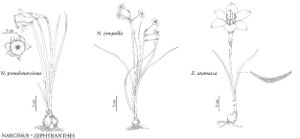Narcissus
Sp. Pl. 1: 289. 1753.
Gen. Pl. ed. 5, 141. 1754.
| Taxon | Illustrator ⠉ | |
|---|---|---|
 | Narcissus pseudonarcissus Narcissus jonquilla Zephyranthes atamasca | Yevonn Wilson-Ramsey Yevonn Wilson-Ramsey Yevonn Wilson-Ramsey |
Herbs perennial, scapose, from ovoid, tunicate bulbs. Leaves (1–) several; blade linear to ligulate, flat to semiterete, fleshy. Inflorescences umbellate in clusters of 2–20, or solitary, spathaceous; spathe 1-valved, enclosing buds, membranous or papery. Flowers pedicellate or sessile, erect or declinate, often fragrant; tepals 6, connate proximally, distinct and reflexed to ascending distally, yellow and/or white; perianth-tube surmounted by a cupular to trumpetlike corona with margins often frilled; stamens 6, epitepalous, often of 2 lengths; filaments separate from corona; anthers basifixed; ovary inferior, 3-locular; style often exserted; stigma minutely 3-lobed. Fruits capsular, 3-locular, papery to leathery, dehiscence loculidical. Seeds numerous, subglobose, often with elaiosomes; testa black. x = 7, 11.
Distribution
Introduced; Europe, n Africa, Asia, and naturalized elsewhere
Discussion
Species ca. 26 (5 in the flora).
Narcissus species and especially a vast array of their natural hybrids and garden cultivars are among the most popular spring flowers (A. Huxley et al. 1992). Many species are extremely variable due to horticultural selection and naturalization. Besides the following species, many of the cultivars also may persist around old gardens, although they never fully naturalize.
All parts of the plant are poisonous, especially the bulb, due to phenanthridine alkaloids such as narcissine and lycorine (G. E. Burrows and R. J. Tyrl 2001).
Selected References
None.
Lower Taxa
Key
| 1 | Inflorescences 1-flowered. | > 2 |
| 1 | Inflorescences umbellate, (1–)2–20-flowered. | > 3 |
| 2 | Corona tubular, ± equal in length to free portions of tepals; tepals yellow; stamens uniseriate. | Narcissus pseudonarcissus |
| 2 | Corona cup-shaped, much shorter than free portions of tepals; tepals white; stamens biseriate. | Narcissus poeticus |
| 3 | Leaf blades nearly terete, 2–4 mm wide; flowers uniformly golden yellow. | Narcissus jonquilla |
| 3 | Leaf blades flat, 6–15(–20) mm wide; flowers white, or yellow and white. | > 4 |
| 4 | Tepals and corona white. | Narcissus papyraceus |
| 4 | Tepals white to cream, corona yellow. | Narcissus tazetta |
"broad" is not a number."thicker" is not a number.